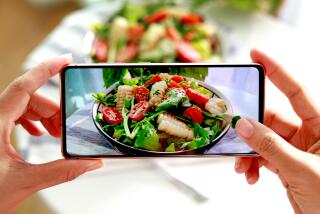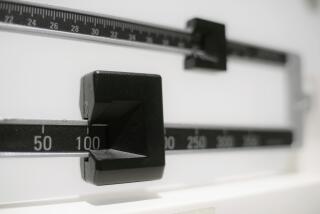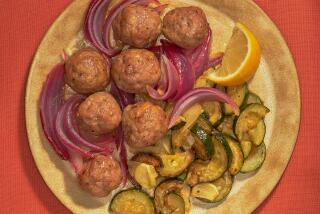Random snacking takes bite out of freelancer’s goals
- Share via
Anne Bogart
Age: 48
Occupation: Freelance director, producer and writer
Height and weight: 5 feet, 5 inches, 160 pounds
Desired weight: 130 pounds
Activity level: Fairly sedentary
Eating pattern: Snacking throughout the day
Exercise routine: Sporadic, low-intensity gym workouts
--
A recent day
6 a.m.: Makes coffee, feeds her two dachshunds.
6:30 a.m.: Wakes daughter Eleanor, then prepares Eleanor’s lunch, cutting the crusts off of a peanut butter sandwich and eating them (115 calories). Pours her daughter a bowl of cereal and eats two handfuls (110 calories). Drinks a cup of black coffee. “In my mind, I haven’t had anything to eat,” Bogart says.
7 a.m.: Allows Eleanor to choose two pieces of leftover Halloween and Easter candy (a miniature Snickers bar and SweeTarts) to put in her lunch bag.
8 a.m.: Arrives at Westside YMCA. Does five minutes of weight machines with light resistance and 30 minutes on the elliptical trainer at level two (burning about 240 calories for her weight; the machine showed 262 calories, but some machines skew about 10% high). Bogart is sweating but doesn’t feel that the workout is taxing.
9:25 a.m.: Arrives home. Heats up black coffee in the microwave, grabs a yogurt (150 calories) and eats it while working in her home office.
10:30 a.m.: Opens the refrigerator and gazes for several minutes. “This is when I go into a trance,” she says, searching for something to eat. “String cheese wouldn’t be bad, but this is the last piece and Eleanor needs it for her lunch. So I’ll have some of this.” Takes two handfuls of shredded cheese (200 calories). “If there were leftovers in here, like pizza, I’d probably eat that.” The food seems more like a work distraction than a way to satisfy hunger.
11:15 a.m.: Back in the kitchen, she takes a handful of wasabi peas (80 calories) and a small handful of shaved Parmesan cheese (85 calories) and goes back to work.
1 p.m.: Lunch is a can of light vegetable barley soup (160 calories). While the soup heats, she eats about five baked tortilla chips, then about 12 more with salsa (160 calories) and the soup.
2:30 p.m.: Picks up Eleanor from school and opens her lunch bag. Finds the uneaten Snickers bar. “This is fair game for Mommy,” she says, but Eleanor protests and the Snickers is left alone. “If I’m really hungry, though,” she says, “I’ll eat whatever is left, like part of her peanut butter sandwich.”
2:45 p.m.: Back home, Bogart prepares an after-school snack for Eleanor of hummus and raw carrots and eats a couple of tablespoons of hummus, along with five tortilla chips (100 calories).
5:20 p.m.: Dinner preparations begin. Bogart cuts up a head of cauliflower, douses it with about five tablespoons of olive oil and puts it in the oven. She puts about a cup of dry brown rice in the rice cooker and sautes a can of garbanzo beans with about three tablespoons of olive oil and a cup of fresh mushrooms. At dinner she eats about a cup of rice (200 calories), three-quarters of a cup of the garbanzo beans (250 calories), and about three-quarters of a cup of the cauliflower (300 calories), and drinks 4 ounces of white wine (100 calories).
Calories consumed: 2,010
Calories burned (using the Harris Benedict Equation; see related story): 1,700
Excess calories: 310
What she needs to do
“All those bites, licks and tastes can sneak up,” says Kara Mohr, co-owner of a Louisville, Ky.-based nutrition and fitness facility. “There are two dangers there. She’s not aware of how much she’s eating because she’s distracted or eating at the countertop. And when she does that, she gives herself the mental green light to eat more, because she doesn’t think she’s eaten anything.”
Mohr’s advice? Keep a food journal to make sure every bite is counted. “She doesn’t have to do it for a lifetime,” Mohr adds, “just until she becomes aware of what her habits are.”
Bogart doesn’t have to completely stop her grazing. But she should plan snacks ahead of time and set portion size.
She also needs to step up her workouts, both in frequency and intensity, says Janet Walberg Rankin, professor of Human Nutrition, Foods & Exercise at Virginia Tech. “I know everyone’s busy,” she says, “but you can work out harder for 30 minutes -- it can still be comfortable, and she won’t be exhausted for the rest of the day. Not everyone likes to do interval training [mixing bouts of high and low intensity], but she could at least bump it up.”
Bogart could add even more activity by walking the dogs or walking to the grocery store. Mohr suggests avoiding the kitchen altogether during her breaks.
“Just make that an off-limit zone,” she says. “Habits can be pretty ingrained, so you almost have to do something drastic to change. But eventually you can break them.”
Rankin recommends a pedometer. “They’re a great way to make people get a handle on how much exercise she’s getting throughout the day,” she says. “That’s good feedback that you can quickly see.”
-- Jeannine Stein


